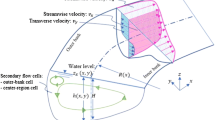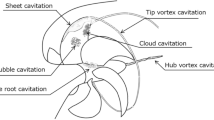Abstract
This study investigates the applicability of the Large Eddy Simulation method with a simple near-wall model to simulate flow separation due to complex immersed geometries. A numerical model was, therefore, developed to solve the governing equations on a staggered Cartesian grid system, in which the flow obstacles are modeled using the immersed boundary method. The near-wall region is approximated using simplified boundary layer equations, aiming at achieving reliable results with a low computational cost. In this study, the accuracy of the numerical model was first evaluated by considering a three-dimensional turbulent flow past an infinite-length circular pile. The corresponding numerical results, particularly the main flow features in the wake region, were found to be in good agreement with experimental and numerical results obtained from reference studies. The numerical model was then applied to simulate the flow around a pile-supported pier, a vital structure in the river and coastal environment, presenting results beyond the former background knowledge available for this case. The available experimental results for the pier case show the good accuracy of the present numerical results. Moreover, the numerical model enabled to characterize the most relevant flow features due to the pier demonstrated the efficiency of the numerical methods employed to study the flow structure formed around complex geometries.












Similar content being viewed by others
References
Beheshti AA, Ataie-Ashtiani B (2010) Experimental study of three-dimensional flow field around a complex bridge pier. J Eng Mech 136:143–154
Yazdi J, Sarkardeh H, Azamathulla HM, Ghani AA (2010) 3D simulation of flow around a single spur dike with free-surface flow. Int J River Basin Manag 8:55–62. https://doi.org/10.1080/15715121003715107
Maghsoodi R, Roozgar MS, Sarkardeh H, Azamathulla HM (2012) 3D-simulation of flow over submerged weirs. Int J Model Simul 32:237–243. https://doi.org/10.2316/journal.205.2012.4.205-5656
Ge L, Lee SO, Sotiropoulos F, Sturm T (2005) 3D unsteady RANS modeling of complex hydraulic engineering flows. II: model validation and flow physics. J Hydraul Eng 131:809–820
Hassanzadeh R, Sahin B, Ozgoren M (2012) Large eddy simulation of free-surface effects on the wake structures downstream of a spherical body. Ocean Eng 54:213–222. https://doi.org/10.1016/j.oceaneng.2012.07.011
Le TB, Khosronejad A, Sotiropoulos F et al (2018) Large-eddy simulation of the Mississippi River under base-flow condition: hydrodynamics of a natural diffluence-confluence region. J Hydraul Res. https://doi.org/10.1080/00221686.2018.1534282
Tessicini F, Iaccarino G, Fatica M et al (2002) Wall modeling for large-eddy simulation using an immersed boundary method. Center for Turbulence Research Annual Research Brief, pp 181–187. https://web.stanford.edu/group/ctr/ResBriefs02/tessicini.pdf
Posa A, Balaras E (2014) Model-based near-wall reconstructions for immersed-boundary methods. Theor Comput Fluid Dyn 28:473–483. https://doi.org/10.1007/s00162-014-0326-5
Beheshti AA, Ataie-Ashtiani B (2016) Scour hole influence on turbulent flow field around complex bridge piers. Flow Turbul Combust 97:451–474. https://doi.org/10.1007/s10494-016-9707-8
Smagorinsky J (1963) General circulation experiments with the primitive equations. Mon Weather Rev 91:99–164
Tremblay F (2001) Direct and large eddy simulation of flow around a circular cylinder at subcritical Reynolds numbers. Dissertation, Technische Universität München
Chu C-R, Chung C-H, Wu T-R, Wang C-Y (2016) Numerical analysis of free surface flow over a submerged rectangular bridge deck. J Hydraul Eng. https://doi.org/10.1061/(asce)hy.1943-7900.0001177
Hu G, Tse KT, Kwok KCS, Zhang Y (2015) Large eddy simulation of flow around an inclined finite square cylinder. J Wind Eng Ind Aerodyn 146:172–184. https://doi.org/10.1016/j.jweia.2015.08.008
Roulund A, Sumer BM, Fredsøe J, Michelsen J (2005) Numerical and experimental investigation of flow and scour around a circular pile. J Fluid Mech 534:351–401. https://doi.org/10.1017/S0022112005004507
Stahlmann A (2014) Numerical and experimental modeling of scour at foundation structures for offshore wind turbines. J Ocean Wind Energy 1:82–89
Baykal C, Sumer BM, Fuhrman DR et al (2015) Numerical investigation of flow and scour around a vertical circular cylinder. Philos Trans R Soc A Math Phys Eng Sci. https://doi.org/10.1098/rsta.2014.0104
Alemi M, Pêgo JP, Maia R (2017) Numerical investigation of the flow behavior around a single cylinder using Large Eddy Simulation model. Ocean Eng 145:464–478. https://doi.org/10.1016/j.oceaneng.2017.09.030
Moin P (1995) Large-Eddy simulation of backward-facing step flow with application to coaxial jet combustors. Technical Report, Stanford University
Sohankar A, Davidson L, Norberg C (2000) Large Eddy simulation of flow past a square cylinder: comparison of different subgrid scale models. J Fluids Eng 122:39–47
Mahesh K, Constantinescu G, Moin P (2004) A numerical method for large-eddy simulation in complex geometries. J Comput Phys 197:215–240. https://doi.org/10.1016/j.jcp.2003.11.031
Kirkil G, Constantinescu SG, Ettema R (2008) Coherent structures in the flow field around a circular cylinder with scour hole. J Hydraul Eng 134:572–587. https://doi.org/10.1061/(ASCE)0733-9429(2008)134:5(572)
Meyer M, Hickel S, Adams NA (2010) Assessment of implicit large-Eddy simulation with a conservative immersed interface method for turbulent cylinder flow. Int J Heat Fluid Flow 31:368–377. https://doi.org/10.1016/j.ijheatfluidflow.2010.02.026
Majander P, Siikonen T (2002) A comparison of time integration methods in an unsteady low-Reynolds-number flow. Int J Numer Methods Fluids 39:361–390. https://doi.org/10.1002/fld.286
Hines J (2008) A comparative study of the SIMPLE and fractional step time integration methods for transient incompressible flows. Dissertation, University of Waterloo
Kim S, Wilson PA, Chen Z (2015) Effect of turbulence modelling on 3-D LES of transitional flow behind a circular cylinder. Ocean Eng 100:19–25
Ünal UO, Atlar M (2010) An experimental investigation into the effect of vortex generators on the near-wake flow of a circular cylinder. Exp Fluids 48:1059–1079
Travin A, Shur M, Strelets M, Spalart P (1999) Detached-Eddy simulations past a circular cylinder. Flow Turbul Combust 63:293–313. https://doi.org/10.1023/A:1009901401183
Lai M, Peskin CS (2000) An immersed boundary method with formal second-order accuracy and reduced numerical viscosity. J Comput Phys 160:705–719. https://doi.org/10.1006/jcph.2000.6483
Acknowledgements
The first author acknowledges the financial support provided by the Islamic Azad University, Minoodasht, Iran. Computational resources were provided by the Faculty of Engineering, University of Porto, Portugal.
Author information
Authors and Affiliations
Corresponding author
Rights and permissions
About this article
Cite this article
Alemi, M., Pêgo, J.P. & Maia, R. Characterization of the Turbulent Flow Around Complex Geometries Using Wall-Modeled Large Eddy Simulation and Immersed Boundary Method. Int J Civ Eng 18, 279–291 (2020). https://doi.org/10.1007/s40999-019-00472-9
Received:
Revised:
Accepted:
Published:
Issue Date:
DOI: https://doi.org/10.1007/s40999-019-00472-9




